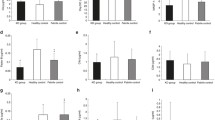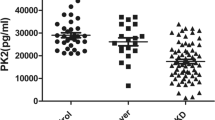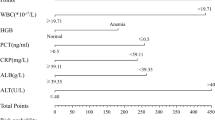Abstract
The diagnosis of acute Kawasaki disease (KD) is based on characteristic clinical signs and not on a specific diagnostic test. The authors performed a comprehensive evaluation of acute-phase reactants in KD to determine which of the acute-phase reactants would most accurately distinguish KD from other febrile illnesses. Blood was collected from 218 cases of febrile children with KD (64 cases); bacterial pneumonia (74 cases); hand, foot, and mouth disease (31 cases); and upper respiratory tract infection (49 cases) in acute-stage illness before any therapy. The demographics, body temperature, and laboratory markers including white blood cell count, red blood cell count, and levels of hemoglobin, platelets, C-reactive protein, haptoglobin, apolipoprotein A-I, and apolipoprotein B were evaluated. Using post hoc analysis, the platelet count (103/μl) and haptoglobin/apolipoprotein A-I ratio were significantly higher for the KD patients (404.64 ± 161.68, P = 0.004; 4.74 ± 2.73, P < 0.001) than for the other groups including patients with pneumonia (272.76 ± 115.07, 2.03 ± 1.88); hand, foot, and mouth disease (274 ± 105.9, 2.24 ± 1.19); and upper respiratory tract infection (282.06 ± 107.72, 1.4 ± 0.98). The best cutoff value of the haptoglobin/apolipoprotein A-I ratio obtained from receiver operating characteristics (ROC) curves for KD was 2 (area under the ROC curve, 0.88; 95% confidence interval, 0.801–0.955), with a sensitivity of 89.7% and a specificity of 85.6% for detecting KD. Our data indicate that the serum haptoglobin/apolipoprotein A-I ratio could be a useful supplemental laboratory marker for the acute phase of KD.

Similar content being viewed by others
References
Cabana VG, Gidding SS, Getz GS, Chapman J, Shulman ST (1997) Serum amyloid A and high-density lipoprotein participate in the acute-phase response of Kawasaki disease. Pediatr Res 42:651–655
Carter K, Worwood M (2007) Haptoglobin: a review of the major allele frequencies worldwide and their association with diseases. Int J Lab Hematol 29:92–110
Fiotti N, Giansante C, Ponte E, Delbello C, Calabrese S, Zacchi T, Dobrina A, Guarnieri G (1999) Atherosclerosis and inflammation: patterns of cytokine regulation in patients with peripheral arterial disease. Atherosclerosis 145:51–60
Gupta M, Noel GJ, Schaefer M, Friedman D, Bussel J, Johann-Liang R (2001) Cytokine modulation with immune gamma-globulin in peripheral blood of normal children and its implications in Kawasaki disease treatment. J Clin Immunol 21:193–199
Henderson RJ, Wasan KM, Leon CG (2008) Haptoglobin inhibits phospholipid transfer protein activity in hyperlipidemic human plasma. Lipids Health Dis 8:27–35
Kawasaki T, Kosaki F, Okawa S, Shigematsu I, Yanagawa H (1974) A new infantile acute febrile mucocutaneous lymph node syndrome (MLNS) prevailing in Japan. Pediatrics 54:271–276
Kim H, Yamaguchi H, Inamo K, Okada T, Harada K (1995) Changes in apolipoproteins during the acute phase of Kawasaki disease. Acta Paediatr Jpn 37:72–676
Kliegman RM, Behrman RE, Jenson HB, Stanton BF (2010) Nelson textbook of pediatrics, 18th edn. Saunders Publishers, UK, pp 1036–1042
Lee WC, Hwang KP, King YT, Chen HC, Chiou SS, Yang RC, Huang TY (2000) Late diagnosis of Kawasaki disease is associated with haptoglobin phenotype. Eur J Clin Invest 30:379–382
Lin CY, Hwang B (1987) Serial immunologic studies in patients with mucocutaneous lymph node syndrome (Kawasaki disease). Ann Allergy 59:91–297
Loy CT, Irwig L (2004) Accuracy of diagnostic tests read with and without clinical information: a systematic review. JAMA 292:1602–1609
Melish ME (1981) Kawasaki syndrome: a new infectious disease? J Infect Dis 143:17–324
Metz CE (1978) Basic principles of ROC analysis. Semin Nucl Med 8:283–298
Newburger JW, Burns JC, Beiser AS, Loscalzo J (1991) Altered lipid profile after Kawasaki syndrome. Circulation 84:625–631
Newburger JW, Takahashi M, Beiser AS, Burns JC, Bastian J, Chung KJ, Colan SD, Duffy CE, Fulton DR, Glode MP (1991) A single intravenous infusion of gamma globulin as compared with four infusions in the treatment of acute Kawasaki syndrome. N Engl J Med 324:1633–1639
Newburger JW, Takahashi M, Gerber MA, Gewitz MH, Tani LY, Burns JC, Shulman ST, Bolger AF, Ferrieri P, Baltimore RS, Wilson WR, Baddour LM, Levison ME, Pallasch TJ, Falace DA, Taubert KA (2004) Diagnosis, treatment, and long-term management of Kawasaki disease: a statement for health professionals from the Committee on Rheumatic Fever, Endocarditis, and Kawasaki Disease, Council on Cardiovascular Disease in the Young, American Heart Association. Pediatrics 114:1708–1733
Spagnuolo MS, Cigliano L, D’Andrea LD, Pedone C, Abrescia P (2005) Assignment of the binding site for haptoglobin on apolipoprotein A-I. J Biol Chem 280:1193–1198
Ueno Y, Takano N, Kanegane H, Yokoi T, Yachie A, Miyawaki T, Taniguchi N (1989) The acute-phase nature of interleukin 6: studies in Kawasaki disease and other febrile illnesses. Clin Exp Immunol 76:337–342
Weng KP, Hsieh KS, Huang SH, Lin CC, Huang DC (1998) Serum HDL level at acute stage of Kawasaki disease. Zhonghua Min Guo Xiao Er Ke Yi Xue Hui Za Zhi 39:28–32
Witt MT, Minich LL, Bohnsack JF, Young PC (1999) Kawasaki disease: more patients are being diagnosed who do not meet American Heart Association criteria. Pediatrics 104:e10
Author information
Authors and Affiliations
Corresponding author
Additional information
M.Y. Huang and J.J. Huang contributed equally, and both considered the first author.
Rights and permissions
About this article
Cite this article
Huang, MY., Gupta-Malhotra, M., Huang, JJ. et al. Acute-Phase Reactants and a Supplemental Diagnostic Aid for Kawasaki Disease. Pediatr Cardiol 31, 1209–1213 (2010). https://doi.org/10.1007/s00246-010-9801-y
Received:
Accepted:
Published:
Issue Date:
DOI: https://doi.org/10.1007/s00246-010-9801-y




